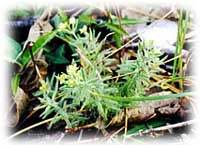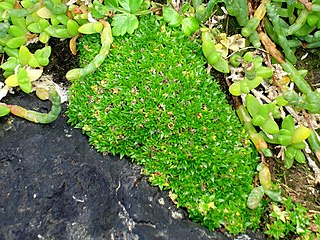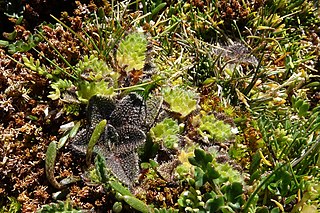
Macquarie Island is an island in the southwestern Pacific Ocean, about halfway between New Zealand and Antarctica. Regionally part of Oceania and politically a part of Tasmania, Australia, since 1900, it became a Tasmanian State Reserve in 1978 and was inscribed as a UNESCO World Heritage Site in 1997.

Galium is a large genus of annual and perennial herbaceous plants in the family Rubiaceae, occurring in the temperate zones of both the Northern and Southern Hemispheres. Some species are informally known as bedstraw.

Sherardia is a monotypic genus of flowering plants in the family Rubiaceae. The genus contains only one species, Sherardia arvensis, the (blue) field madder, which is widespread across most of Europe and northern Africa as well as southwest and central Asia and Macaronesia. It is also reportedly naturalized in Australia, New Zealand, Taiwan, Kerguelen, Ethiopia, Sudan, southern Africa, Mexico, Costa Rica, South America, Bermuda, Cuba, Haiti and much of Canada and the United States.

Galium verum is a herbaceous perennial plant of the family Rubiaceae. It is widespread across most of Europe, North Africa, and temperate Asia from Israel, Lebanon and Turkey to Japan and Kamchatka. It is naturalized in Tasmania, New Zealand, Canada, and the northern half of the United States. It is considered a noxious weed in some places.

Galium uliginosum or fen bedstraw is a plant species of the genus Galium. It is widespread across most of Europe as well as Morocco, Western Siberia, Turkey, Kazakhstan and Xinjiang. It is reportedly naturalized in New Zealand, Greenland and the Crozet Islands.

Galium saxatile or heath bedstraw is a plant species of the genus Galium. It is related to cleavers.

The Antarctic Floristic Kingdom, also the Holantarctic Kingdom, is a floristic kingdom that includes most areas of the world south of 40°S latitude. It was first identified by botanist Ronald Good, and later by Armen Takhtajan. The Antarctic Floristic Kingdom is a classification in phytogeography, different from the Antarctic realm classification in biogeography, and from Antarctic flora genera/species classifications in botany.

Galium californicum is a species of flowering plant in the coffee family known by the common name California bedstraw.

Galium aparine, with common names including cleavers, clivers, catchweed, robin-run-the-hedge, goosegrass and sticky willy, is an annual, herbaceous plant of the family Rubiaceae.

Pleurophyllum hookeri, also known as the silver-leaf daisy or sage-green rosette herb, is a herbaceous plant in the family Asteraceae, a megaherb native to the subantarctic Auckland and Campbell Islands of New Zealand and Australia’s Macquarie Island. It grows up to 900 mm in height and has crimson button flowers and long, silky, silver leaves, with a large carrot-like tuber and long roots. It also has the unusual feature of a vertically contractile stem, most of which is underground, which serves to keep the leaf rosette close to the ground surface and the plant anchored securely against the very strong winds typical of subantarctic islands. Prior to the successful eradication of introduced mammals on Macquarie Island in 2011, it had been threatened there by black rats and European rabbits.

Colobanthus muscoides is a low-growing, moss-like flowering cushion plant in the family Caryophyllaceae, found on islands in the south-western Pacific Ocean, especially in the subantarctic region. The specific epithet comes from the Latin muscus (moss) and -oides (resembling), with reference to its growth habit.

Juncus scheuchzerioides is a species of rush variously called short rush or greater rush. It has an Antarctic circumpolar distribution and is native to many subantarctic islands in, and on the regions bordering, the Southern Ocean.

Coprosma perpusilla, commonly known as creeping coprosma, is a species of flowering plant in the family Rubiaceae. It is found in Australia, New Zealand and on some subantarctic islands. The specific epithet comes from the Latin per (very) and pusillus, referring to the growth habit.

Leptinella plumosa is a small flowering plant in the daisy family. It is a circumantarctic species found on many subantarctic islands in the Southern Ocean. The specific epithet comes from the Latin for “feathery”, referring to the form of the leaves.
Callitriche antarctica, commonly known as the Antarctic water-starwort, is a small, prostrate plant with tiny yellow flowers in the family Plantaginaceae. It is found in wet places on many subantarctic islands and has a wide circumantarctic distribution, something reflected in its specific epithet.

The wildlife of Antarctica are extremophiles, having adapted to the dryness, low temperatures, and high exposure common in Antarctica. The extreme weather of the interior contrasts to the relatively mild conditions on the Antarctic Peninsula and the subantarctic islands, which have warmer temperatures and more liquid water. Much of the ocean around the mainland is covered by sea ice. The oceans themselves are a more stable environment for life, both in the water column and on the seabed.

Galium obtusum, the bluntleaf bedstraw, is a herbaceous plant species in the family Rubiaceae. Bluntleaf bedstraw is a wildflower native to eastern North America.

Justine Shaw is an Australian Antarctic researcher, best known for her conservation work on subantarctic islands, currently working at the Queensland University of Technology. She has a wide global research network, having worked in Australia, South Africa, sub-Antarctic/Antarctic and the Arctic.

Myosotis antarctica is a species of flowering plant in the family Boraginaceae, native to mainland New Zealand, Campbell Island and southern Chile. Joseph Dalton Hooker described the species in his 19th century work Flora Antarctica. Plants of this species of forget-me-not are perennial with a prostrate habit, bracteate inflorescences, and white or blue corollas. It is one of two native species of Myosotis in the New Zealand subantarctic islands, the other being M. capitata, which also has blue corollas.

Myosotis antarcticasubsp. antarctica is a subspecies of flowering plant in the family Boraginaceae, native to New Zealand, Campbell Island, and southern Chile. Joseph Dalton Hooker described the species in his 19th century work Flora Antarctica. Plants of this subspecies of forget-me-not are perennial with a prostrate habit, bracteate inflorescences, and white or blue corollas. It is one of two native Myosotis in the New Zealand subantarctic islands, the other being M. capitata, which also has blue corollas.


















